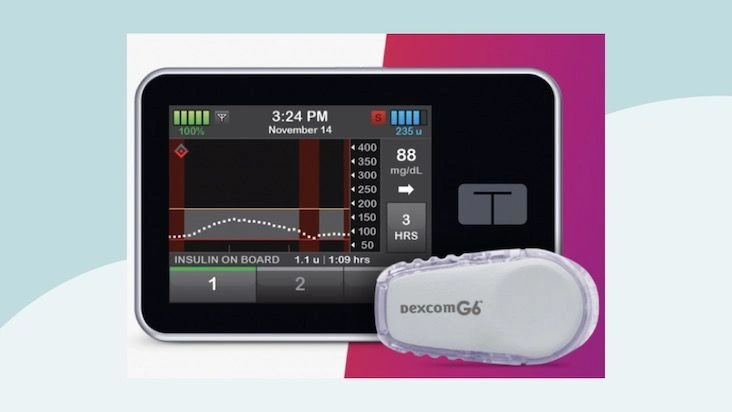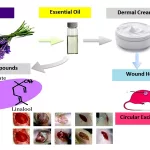One of the more sophisticated diabetes management tools on the market is Tandem Diabetes Care’s touchscreen insulin pump. Its intelligent software forecasts glucose trends and modifies insulin delivery automatically when needed.
The initial iteration of this technology is called Basal‑IQ, a software capability integrated into the t:slim X2 pump aimed at preventing hypoglycemia and helping keep glucose within target ranges.
Basal‑IQ received FDA clearance in June 2018 and has been on the market since that summer.
The system links the color touchscreen t:slim X2 pump with the Dexcom continuous glucose monitor (CGM) to enable predictive glucose tracking and automatic insulin suspension when a low is forecasted.
It leverages the t:slim X2’s capacity for remote software updates at home, allowing new capabilities to be added without purchasing a new pump whenever software improvements are released.
Below, Healthline reviews the main features, benefits and drawbacks, user impressions, and cost aspects of this partially automated insulin delivery (AID) system.
(Note: Tandem also offers a more advanced AID called Control‑IQ; some users nonetheless prefer Basal‑IQ’s behavior. Read on for more details.)
What is Tandem Basal‑IQ?
Tandem Basal‑IQ is a combined system that pairs the Tandem t:slim X2 insulin pump with the Dexcom G6 CGM, using the Basal‑IQ algorithm to help maintain glucose in range. The software can automatically pause insulin delivery for short intervals if it predicts low blood glucose.
It triggers a suspension in two scenarios:
- when you drop below 70 mg/dL
- when the algorithm predicts you will fall below 80 mg/dL within the next 30 minutes
In both cases, Basal‑IQ restarts insulin delivery once glucose starts rising. The algorithm relies on three of the last four CGM readings to decide on an auto‑suspend. The pump’s main display shows red indicators to show when and how long insulin delivery was paused.
Users may opt to silence alerts for each suspension, letting Basal‑IQ operate quietly in the background with fewer interruptions. For some, this reduces device-related fatigue.
Pros and cons
The t:slim X2 insulin pump

The t:slim X2 is the platform’s centerpiece and is unique among pumps for offering a full‑color touchscreen.
It supports remote software updates from home similar to smartphone updates.
This innovation means you aren’t forced to buy new hardware every time Tandem enhances functionality.
Tandem pumps are distinctive for their color touchscreen, but for safety there’s a required three‑button wake and confirmation process to access the device.
You tap the on‑screen 1‑2‑3 buttons when prompted to unlock it. Most tasks prompt at least one confirmation step — whether delivering a mealtime or correction bolus, entering carbs or a glucose value, or pausing insulin for an activity like swimming.
Because the system pairs with the Dexcom G6 CGM (worn separately), the pump screen also displays CGM status and glucose data.
Pressing the silver “T” wakes the device and reveals the full‑color CGM status screen showing glucose trace, battery and transmitter status, insulin on board (IOB), and insulin reservoir volume.
The CGM’s default trace is 3 hours, but you can scroll to 1‑, 6‑, 12‑, and 24‑hour views without redoing the three‑button unlock.
Many users find the t:slim X2 intuitive compared with alternatives, although there are some common annoyances:
- Potential leakage: Tandem’s unique twist‑and‑connect tubing pigtail has raised concerns over time about possible insulin leaks or air entering the line.
- Multiple confirmations: The unlock and confirmation steps can be frustrating for people with larger fingers or limited dexterity. A “three strikes” lockout after touching inactive areas forces you to restart the unlock sequence.
- Non‑silenceable alarms: Several alarms (for example, “empty cartridge”) cannot be muted, so persistent beeps may occur if you delay changing cartridges.
Dexcom G6 CGM
Basal‑IQ relies on the Dexcom G6 CGM, the company’s then‑current generation as of mid‑2022.
To use Basal‑IQ you must acquire Dexcom G6 consumables and Tandem supplies separately.
The G6 is widely regarded for comfort, accuracy, and ease of use.
It is FDA‑cleared for non‑adjunctive dosing, so finger‑sticks aren’t required before making insulin dosing decisions. It self‑calibrates but also allows manual calibration if you prefer to enter a finger‑stick value.
Dexcom G6 sensors are approved to remain on the body for 10 days. If a sensor fails early, Basal‑IQ users can contact Dexcom or Tandem support for replacements.
Some users report intermittent Bluetooth dropouts between the t:slim X2 and the G6 transmitter, particularly when the pump is worn opposite the CGM site.
Mobile app and t:connect software

Tandem introduced its mobile app in 2020, letting users view pump and CGM information and many system features (Basal‑IQ or Control‑IQ).
An updated app released in early 2022 added features; some users can dose from their iOS phones through the app rather than only from the pump.
Basal‑IQ also integrates with Tandem’s t:connect web software for data review and sharing. With permission, your diabetes care team can access your account to assist with management decisions.
How well does Basal‑IQ work?
The key question is how effectively this partial automation reduces low blood sugars.
Clinical evidence is generally favorable.
A 2018 trial demonstrated that the predictive algorithm significantly cut hypoglycemia without causing rebound hyperglycemia in both adults and children with type 1 diabetes.
Importantly, 99% of participants completed that study — a much higher retention than a competing system at the time, which saw dropouts related to perceived accuracy and usability issues.
A 2019 real‑world analysis of voluntary submissions from over 5,000 Basal‑IQ users found high levels of satisfaction, trust, and usability, and many reported improved sleep and overall diabetes control.
User feedback and reviews
Members of the diabetes community have shared a range of experiences with Basal‑IQ.
Connecticut parent Samantha Merwin, whose son Logan took part in Basal‑IQ trials, called it “truly a miracle for us,” especially at night when she could see how often insulin had been suspended.
Early adopter Brian Mozisek from Texas praised Basal‑IQ’s ability to prevent lows during intense activity and said it allowed him to more confidently adjust settings to manage higher glucose levels that the system does not directly handle.
Basal‑IQ is ‘mostly crazy wonderful’
As a longtime person with type 1 diabetes who has used Tandem gear, I found Basal‑IQ softened the impact of hypoglycemia without eliminating every low. Its predictive auto‑suspend prevented severe drops and gave me more confidence sleeping through the night.
Because I experience limited overnight hypoglycemia symptoms (hypoglycemia unawareness), this feature offers meaningful reassurance to both me and my partner.
Type 1 veteran Wil Dubois in New Mexico described Basal‑IQ as “crazy wonderful most of the time.” In his trialing, it added a new level of CGM integration and control. He did note it sometimes missed slow, gradual “coasting lows” that develop over several hours.
Complaints about Tandem t:slim X2 technology
As with any device, users have reported downsides. Common complaints include:
False lows: Like all CGM sensors, the Dexcom G6 can occasionally give inaccurate readings, for instance when pressure on the sensor during sleep causes a “compression low.” This can lead Basal‑IQ to unnecessarily suspend insulin until the reading corrects once pressure is relieved.
Repeat data entry: If you want to give a correction bolus for a high glucose, you must manually enter the CGM glucose into the pump before delivering that bolus. It’s somewhat puzzling given the Bluetooth link and available CGM data, but this behavior stems from Basal‑IQ only automating responses to lows.
Low dosing lock: When Basal‑IQ has suspended insulin for low glucose, you can’t add insulin to cover carbs you’re about to eat until insulin delivery resumes. That can be inconvenient if you plan to eat and want to prevent a rebound high.
Snooze mode cancellation: If you temporarily disable Basal‑IQ predictive suspends (snooze it), starting an extended bolus before activating snooze will cause the system to cancel any remaining portion of that extended bolus.
No schedule profiles: There’s no automatic switching between basal profiles — you must manually activate alternate profiles (for example, a weekend profile) when desired.
How does Basal‑IQ compare to Control‑IQ?
Tandem’s more recent Control‑IQ adjusts insulin for both impending lows and highs and includes additional features to boost time in range. Control‑IQ became available in 2020.
Both systems run on the t:slim X2, but you cannot downgrade once you upgrade: moving from Basal‑IQ to Control‑IQ is irreversible per regulatory constraints.
There are tradeoffs: some people preferred Basal‑IQ’s simplicity and felt Control‑IQ didn’t fit as well with their individual needs.
Research both systems and consider personal priorities before choosing. For more detail, see a full Control‑IQ review.
What does Tandem Basal‑IQ cost?
Cost can be a major downside for pump‑CGM combinations.
You can buy a t:slim X2 pump by itself, but Basal‑IQ’s utility depends on pairing with a Dexcom CGM, so you must purchase both systems and their consumables.
Out of pocket, the t:slim X2 retails around $4,000. With private insurance, some plans cover up to about 80% of that amount.
Dexcom G6 sensor and transmitter costs can add up — we estimate around $6,000 per year (about $500 per month) based on 10‑day sensors and 90‑day transmitters.
Check for manufacturer discount programs and review your insurance benefits for coverage specifics.
How to get started
You must order the Tandem t:slim X2 pump directly from Tandem.
Dexcom CGM supplies can be purchased through distributors like Edgepark or at U.S. retail pharmacies such as CVS, Rite Aid, and Walgreens.
Steps to begin with Tandem Basal‑IQ:
- Discuss with your endocrinologist or diabetes care team whether an insulin pump, CGM, and specifically Tandem devices are appropriate for you.
- Confirm coverage and out‑of‑pocket costs with your insurance provider.
- Contact Tandem Diabetes Care (directly or via your clinic) to start the acquisition process. Tandem will coordinate with your prescriber and insurer to determine coverage and pricing, which can take days to weeks.
- Once prescription and insurance are cleared, Tandem will coordinate delivery of the pump and supplies through you or your supplier.
- After receiving the device, you’ll work with a Tandem trainer or your diabetes team to set up appropriate settings and learn the system using manuals, videos, and training resources.
- Expect a learning curve: these devices often take time to adapt to. Initial settings may need adjustment as you gain experience. Keep return policy timelines in mind if you decide it isn’t right for you.
Alternative options to Basal‑IQ
By mid‑2022, other AID systems available in the U.S. included Medtronic’s MiniMed 770G and the Insulet Omnipod 5. Tandem also offers Control‑IQ as a more feature‑rich option.
Quick summaries of the alternatives:
Medtronic MiniMed 770G:This system combines Medtronic pump and CGM with an algorithm and apps to monitor glucose and pump data. Like Control‑IQ, it addresses both highs and lows. One benefit is single‑manufacturer integration (pump and CGM). Drawbacks cited include an older design without a touchscreen and a CGM that some find less comfortable than Dexcom.
Omnipod 5: The only tubeless patch pump available in the U.S., released in early 2022, representing one of the most advanced options. It supports a customizable glucose target instead of a fixed set point.
Tandem Control‑IQ: Introduced in 2020, Control‑IQ is a step up from Basal‑IQ by automatically modifying insulin for both low and high glucose events.
Below is a brief comparison based on product specs and reported user experience:
Basal‑IQ | Control‑IQ | MiniMed 770G | Omnipod 5
Design: horizontal with color touchscreen | small horizontal pump with color touchscreen | vertical, smartphone‑sized, screen buttons | only tubeless patch pump in U.S.
CGM connection: Dexcom G6 (10‑day sensors; finger‑stick not required) | Dexcom G6 (10‑day sensors; finger‑stick not required) | MiniMed Guardian 3 (6–7 days; 2–3 finger‑stick calibrations/day) | Dexcom G6 (10‑day sensors; finger‑stick not required)
Warmup: 2 hours for CGM data warmup | 2 hours for CGM data warmup | no CGM data during 2‑hour warmup; 48‑hour warmup before auto‑mode | 2 hours for CGM data warmup, but still in auto mode
Set target: 112.5 mg/dL | 120 mg/dL | customizable 110–150 mg/dL | customizable
Suspends insulin: yes | yes | yes | yes
Auto corrections: no | 60% of programmed rate to 110 mg/dL target | no | yes, via frequent small microboluses
Phone app: yes, limited pump control | yes, limited pump control | yes, but no pump control | uses smartphone app or separate controller
Special modes: no | exercise + sleep modes for higher glucose targets and auto‑corrections | manual and auto modes | activity feature for higher target and reduced basal
Beyond FDA‑regulated pumps, other automated options include:
Smart insulin pen systems: The Bigfoot Unity AID system earned FDA clearance in May 2021 and links an insulin pen with a CGM to provide connected features for people on multiple daily injections.
DIY devices: Some technically inclined individuals build DIY AID solutions using Dexcom CGMs, compatible pumps, and open‑source algorithms (OpenAPS or Loop). These setups can function similarly to commercial AID systems but require substantial setup and are not FDA‑approved.
Frequently asked questions
How much does the t:slim X2 insulin pump cost?
Insulin pumps and supplies can be costly, though many insurance plans cover them.
Without insurance, the t:slim X2 pump retails around $4,000. With private insurance, some plans reimburse up to ~80%.
Monthly supplies (infusion sets, insulin cartridges) can range from about $70 to $400 depending on usage and coverage.
Basal‑IQ users must also buy Dexcom G6 supplies; annual sensor and transmitter costs may total roughly $6,000.
What insulin does the t:slim use?
The t:slim X2 is compatible with most rapid‑acting insulins in the U.S., including Humalog and Novolog. Some users also use Apidra or Fiasp, though recommendations vary.
How long does the t:slim insulin pump last?
The t:slim X2 carries a 4‑year warranty. Insurance policies differ in how they define replacement timing for pumps. Lifespan also depends on wear and tear; manufacturers typically offer loaner devices if repairs or replacements are needed.
How often do you change t:slim insulin pump sites?
Clinicians generally advise rotating infusion sites every 2 to 4 days, inserting a new set and replacing the insulin cartridge. You’ll need to prime tubing with insulin (often at least 10 units) and ensure a small fill reaches the cannula.
Bottom line
Many people find Basal‑IQ to be a valuable tool — Tandem built a compelling system that reduces the risk of lows. Remember, though, Basal‑IQ addresses only one side of glucose control: it prevents or mitigates hypoglycemia but does not actively correct highs.
Adopting a partially automated approach can feel unsettling for those used to manual control, yet many users discover that after learning how it works, Basal‑IQ provides crucial protection against dangerous lows.
Tandem’s online training resources can be helpful for new users to get up to speed and use the system effectively.


















Leave a Reply
You must be logged in to post a comment.